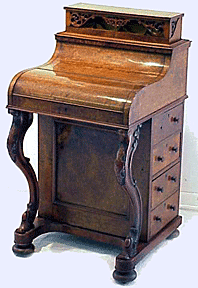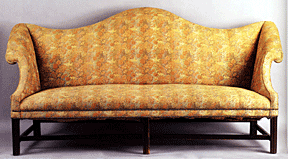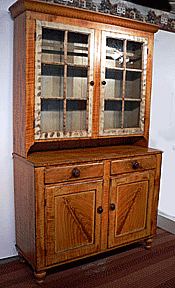What is That Piece of
Furniture Called?
by
Bob Brooke
 Do
you sometimes get confused with furniture names? If you’re a collector
of antiques, you probably have found that the same name can often refer
to several different kinds of furniture. If you’re just starting to
collect antiques, you’re probably just downright confused. Furniture
was named in two ways: After its use or after its maker or manufacturer.
Knowing that will help you in purchasing older pieces that may have
names that seem strange to you today, for over time many furniture names
have changed through use and have become part of the vernacular of
English. Do
you sometimes get confused with furniture names? If you’re a collector
of antiques, you probably have found that the same name can often refer
to several different kinds of furniture. If you’re just starting to
collect antiques, you’re probably just downright confused. Furniture
was named in two ways: After its use or after its maker or manufacturer.
Knowing that will help you in purchasing older pieces that may have
names that seem strange to you today, for over time many furniture names
have changed through use and have become part of the vernacular of
English.
For instance, Lambert Hitchcock of
Hitchcocksville,
Connecticut, created the first mass-produced chair which today bears his
name. The Boston rocker originated in a cabinetmaker’s shop in Boston.
The davenport, a small desk with a hinged lid that opens out for
writing, was originally made by William Davenport. Later, a large sofa
which sometimes converted into a bed also became known as a davenport.
In colonial days, a bed meant a featherbed or
mattress. The frame was known as a bedstead. Mirrors were known as
looking glasses. A chest with four or more drawers was known as a
high-daddy.
One of the oddest pieces of furniture is the commode.
Initially a French chest of drawers on legs, later called a chiffonier
and moved to refer to a movable washstand, with basin, waste pipe, etc.
to a piece of furniture containing a chamber pot. Finally, the name
became a pseudo-intellectual name for the common toilet.
 Sofa, couch, love seat, or divan–all refer to the
same type of seating. Or do they? A couch was actually a bed, from coucher, the French word meaning to lie down. A settee was an elongated
armchair that accommodated two or more people. Developed in the 17th
century, it was often upholstered. Sofa, couch, love seat, or divan–all refer to the
same type of seating. Or do they? A couch was actually a bed, from coucher, the French word meaning to lie down. A settee was an elongated
armchair that accommodated two or more people. Developed in the 17th
century, it was often upholstered.
A love seat was and still is a long seat consisting of
two seating cushions and intended to accommodate two people. Anything
with more than two cushions was called a sofa.
The sofa’s origins appear to stem from the French
day-bed, referring to any type of elongated seating, including the
chaise longue, or “long chair,” designed for resting rather than
sleeping. It usually had a raised end. While most early sofas were
upholstered, springs weren’t used in them until the early 19th
century.
An ottoman was an upholstered footstool or low bench
without arms or back, named after the Turkish influence of the early
18th century.
 Case furniture, that is furniture used for storage,
came in all sorts of forms. The trendy armoire was originally a large
mobile cupboard or wardrobe featuring doors and shelves for clothes
storage. A German variation was known as a kas. A more modern version,
also containing drawers, came to be called a wardrobe. Case furniture, that is furniture used for storage,
came in all sorts of forms. The trendy armoire was originally a large
mobile cupboard or wardrobe featuring doors and shelves for clothes
storage. A German variation was known as a kas. A more modern version,
also containing drawers, came to be called a wardrobe.
Chests also came in many varieties. Originally a piece
of squared furniture with drawers, it became known as a commode to the
French. A variation used a desk, featuring a fall-front, a cylinder
front or a tambour (roll-top) was called a bureau. A low English chest
of drawers on long legs was known as a lowboy and later as a dressing
table. By mounting a chest of drawers on top of it, it became a highboy,
from the French haut bois which means "high wood."
Dining rooms had a sideboard, a table with a wide
drawer at the center flanked by drawers or cupboards on the sides and
made to be used against a dining room wall for storing and serving food.
Sideboards began as credenzas, a serving table with a cupboard below the
surface, in the 15th Century. In the 16th Century, an upper, recessed
tier was added. This was also known as a “dresser,” where dishes
were dressed before serving. Today, this piece of furniture is commonly
called a buffet, based on its use as a vehicle for self-serve dinners.
Today’s china closet was originally called a vitrine,
a cabinet with a glass door. The sides and top were often also of glass,
and it was designed to store and display china and curios.
Lastly, to keep milk and freshly-baked pies protected
from flies, simple cupboards, known as pie and milk safes, with doors
fitted with decorative, pierced tin panels to let the air circulate
through them, were popular from the 1820's to after the Civil War.
To read
more of my articles, please
visit
my Web site.
<
Back to Antiques Articles
Next Article >
|
